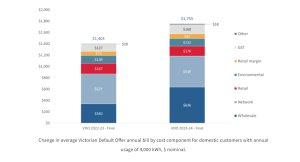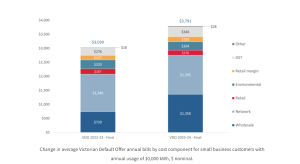Well, it’s official – default power prices rose by as much as 25% for households across New South Wales, Victoria, south-east Queensland and South Australia from July 1, according to the energy regulators.
After drafting hikes of as much as 31% back in March, the Australian Energy Regulator (AER) and Essential Services Commission (ESC) confirmed significant price hikes came into effect on July 1 for the Default Market Offer (DMO) and Victorian Default Offer (VDO) in the relevant states.
The biggest price pains were felt by single-rate residential customers in Victoria, with a 25% or $352 average annual price spike hitting bills. Following Victorians, it was South Australians slugging a 23.9% or $439 rise while Queenslanders copped a 21.5% or $349 jump.
Across all three of New South Wales’ distribution networks, prices rose by between 20.8% and 21.4% or as much as $435.
What does this mean for market electricity offers?
It is important to note that the July 1 price changes were only directly applicable to households on default electricity plans, such as the DMO in NSW, SEQ and SA and the VDO in Victoria. This constituted about 10% of households in NSW, SEQ and SA and 15% of households in Victoria.
However, it is not far-fetched to assume that these price hikes will now play a role in dictating pricing for market offer plans beyond July 1.
Market offers are those that are designed by retailers and typically come with discounts, bill credits, competitive rates or other sign-up incentives to help reduce costs for consumers. These plans act as a point of difference for retailers, providing value add-ons to sway customers and their back pocket.
With default offers acting as a baseline for retailers to work off, market offer pricing then may fluctuate as companies work to readjust their costs to both maintain their margins and present an attractive and ‘cheaper’ offer to its customers or interested households potentially looking to make the switch.
The amount of savings a customers could have when switching to a market offer is usually indicated by the percentage difference listed to the Reference Price or VDO in a relevant area. The higher the number, typically, the more savings that could be on offer to households. However, it is important to note that some calculations may include the costs of a conditional discount, such as paying on time. As such, always be sure to read the fine print before signing up to an electricity offer.
For an idea of what you could be currently saving off the default price, we have listed some of the cheapest plans available in Sydney, Melbourne, Brisbane and Adelaide below with their percentage difference to the default price in that area.
Could you be saving off the default price? See the cheapest offers currently available
Here are some of the cheapest published deals from the retailers on our database that include a link to the retailer’s website for further details. These are products from referral partners†. These costs are based on the Ausgrid network in Sydney but prices may vary depending on your circumstances. This comparison assumes general energy usage of 3900kWh/year for a residential customer on a single rate tariff. Please use our comparison tool for a specific comparison in your area. Our database may not cover all deals in your area. As always, check all details of any plan directly with the retailer before making a purchase decision.
Here are some of the cheapest published deals from the retailers on our database that include a link to the retailer’s website for further details. These are products from referral partners†. These costs are based on the Citipower network in Melbourne but prices may vary depending on your circumstances. This comparison assumes general energy usage of 4000kWh/year for a residential customer on a single rate tariff. Please use our comparison tool for a specific comparison in your area. Our database may not cover all deals in your area. As always, check all details of any plan directly with the retailer before making a purchase decision.
Here are some of the cheapest published deals from the retailers on our database that include a link to the retailer’s website for further details. These are products from referral partners†. These costs are based on the Energex network in Brisbane but prices may vary depending on your circumstances. This comparison assumes general energy usage of 4600kWh/year for a residential customer on a single rate tariff. Please use our comparison tool for a specific comparison in your area. Our database may not cover all deals in your area. As always, check all details of any plan directly with the retailer before making a purchase decision.
Here are some of the cheapest published deals from the retailers on our database that include a link to the retailer’s website for further details. These are products from referral partners†. These costs are based on the SA Power network in Adelaide but prices may vary depending on your circumstances. This comparison assumes general energy usage of 4000kWh/year for a residential customer on a single rate tariff. Please use our comparison tool for a specific comparison in your area. Our database may not cover all deals in your area. As always, check all details of any plan directly with the retailer before making a purchase decision.
Why have prices increased?
The ESC and AER both attributed to the price increases to wholesale electricity forecasts and network tariffs. The final price however, did take into account the recently announced federal energy bill relief.
When announcing the final default price in late-May 2023, AER Chair Ms Clare Savage said despite the changes, cost-of-living concerns remained at the forefront of the regulator’s mind during the decision process.
“We know households and small businesses continue to face cost-of-living pressures on many fronts, and that’s why it’s important the DMO provides a safety net for those who might not have shopped around for a better power deal,” she said. “In setting the DMO price this year we have sought to protect consumers from unjustifiably high prices and at the same time allow retailers to offer consumers better deals than their standard plans.”
Price rises mean more support is needed for Aussie households
Energy Consumers Australia Interim Chief Executive Officer Jacqueline Crawshaw said the DMO and VDO underlined an urgency for more support regarding household energy costs.
“These increases come on top of double-digit increases the previous year and are another blow for consumers,” she said. “The Federal Budget’s Energy Bill Relief Fund package will help to counter bill shock for millions of eligible households and small businesses. It’s clear that consumers need additional support so they can better manage their bills.”
Energy Consumers Australia is an independent group that represents energy consumers and provides practical advice on how to manage energy costs in Australia.
Ms Crawshaw reiterated that hands-on advice is vital to supporting households as they navigate higher energy costs.
“Providing consumers with practical advice around the simple things they can do to reduce their energy use and bills will help with cost-of-living pressures being felt now but also support a successful energy transition in the future,” she said.
Households or small businesses who may already be struggling to pay their energy bills have been urged to reach out to their retailer for support.
Struggling to pay your energy bills? See what support you may be eligible for in Canstar Blue’s bill support guide.
At the time of the VDO release, Victoria’s commissioner and chairperson Kate Symons said: “If you are a residential customer and you’re having trouble paying your bill, you are entitled, under Victorian energy law, to assistance from your retailer. Contact your retailer as soon as possible to get help. Ask your energy retailer about payment plans, and what concessions, rebates or utility relief grants are available.”
The Federal Budget’s Energy Bill Relief Fund is now available to households and small businesses.
What do prices actually look like in each state?
Below, we have listed the new DMO and VDO for each relevant state. These have been broken down by costs for households and small businesses, dependent on their distribution network and whether they have a single rate or controlled load tariff.
Final DMO Prices in NSW
Residential Customers (single rate only)
| Distribution Network | 2023-24 DMO Prices | Annual Increase |
|---|---|---|
| Ausgrid | $1,827 | $315 (20.8%) |
| Endeavour Energy | $2,228 | $392 (21.4%) |
| Essential Energy | $2,527 | $435 (20.8%) |
Residential Customers (controlled load)
| Distribution Network | 2023-24 DMO Prices | Annual Increase |
|---|---|---|
| Ausgrid | $2,562 | $440 (20.7%) |
| Endeavour Energy | $2,997 | $594 (24.9%) |
| Essential Energy | $2,997 | $487 (19.6%) |
Small Business Customers (single rate only)
| Distribution Network | 2023-24 DMO Prices | Annual Increase |
|---|---|---|
| Ausgrid | $4,999 | $639 (14.7%) |
| Endeavour Energy | $4,598 | $816 (21.6%) |
| Essential Energy | $5,761 | $860 (17.5%) |
Source: AER Default Market Offer 2023–24 final determination – May 25, 2023.
Final DMO Prices in SEQ
Residential Customers (single rate only)
| Distribution Network | 2023-24 DMO Prices | Annual Increase |
|---|---|---|
| Energex | $1,969 | $349 (21.5%) |
Residential Customers (controlled load)
| Distribution Network | 2023-24 DMO Prices | Annual Increase |
|---|---|---|
| Energex | $2,363 | $402 (20.5%) |
Small Business Customers (single rate only)
| Distribution Network | 2023-24 DMO Prices | Annual Increase |
|---|---|---|
| Energex | $4,202 | $756 (21.9%) |
Source: AER Default Market Offer 2023–24 final determination – May 25, 2023.
Final DMO Prices in SA
Residential Customers (single rate only)
| Distribution Network | 2023-24 DMO Prices | Annual Increase |
|---|---|---|
| SAPN | $2,279 | $439 (23.9%) |
Residential Customers (controlled load)
| Distribution Network | 2023-24 DMO Prices | Annual Increase |
|---|---|---|
| SAPN | $2,787 | $512 (22.5%) |
Small Business Customers (single rate only)
| Distribution Network | 2023-24 DMO Prices | Annual Increase |
|---|---|---|
| SAPN | $5,849 | $1,310 (28.9%) |
Source: AER Default Market Offer 2023–24 final determination – May 25, 2023.
Final VDO Prices in VIC
Please note, this is an average price, based on all five of Victoria’s distribution networks.
Residential Customers

Small Business Customers

Can Aussies save money by switching their energy plans?
It is important to note that the default power price is intended to act as a safety net for those consumers that are either unable or uninterested in actively partaking in the energy market. As such, there is the potential for cheaper deals to be available to you in the form of a market offer.
According to data from the AER in late April 2023, households who switched from a default or standing offer to the lowest market offer at the time, could have saved between 8% and 17% depending on location. Small businesses could have cashed in on a 18% to 34% saving for doing the same.
Canstar Blue Utilities Editor Tara Donnelly said it paid to keep an eye on offers as regularly as possible, particularly in the few weeks following July 1.
“With July 1 being a significant annual event for energy retailers you may find that providers will use this time to offer their most attractive incentives or cheaper pricing. Even now, there is the opportunity to save hundreds off the DMO and VDO in each state, so keeping ahead of the pack and regularly comparing offers may prove a smart move, financially, for your household.”
Image credit: Anastasija Vujic/Shutterstock.com
Original article published May 25, 2023.


Share this article